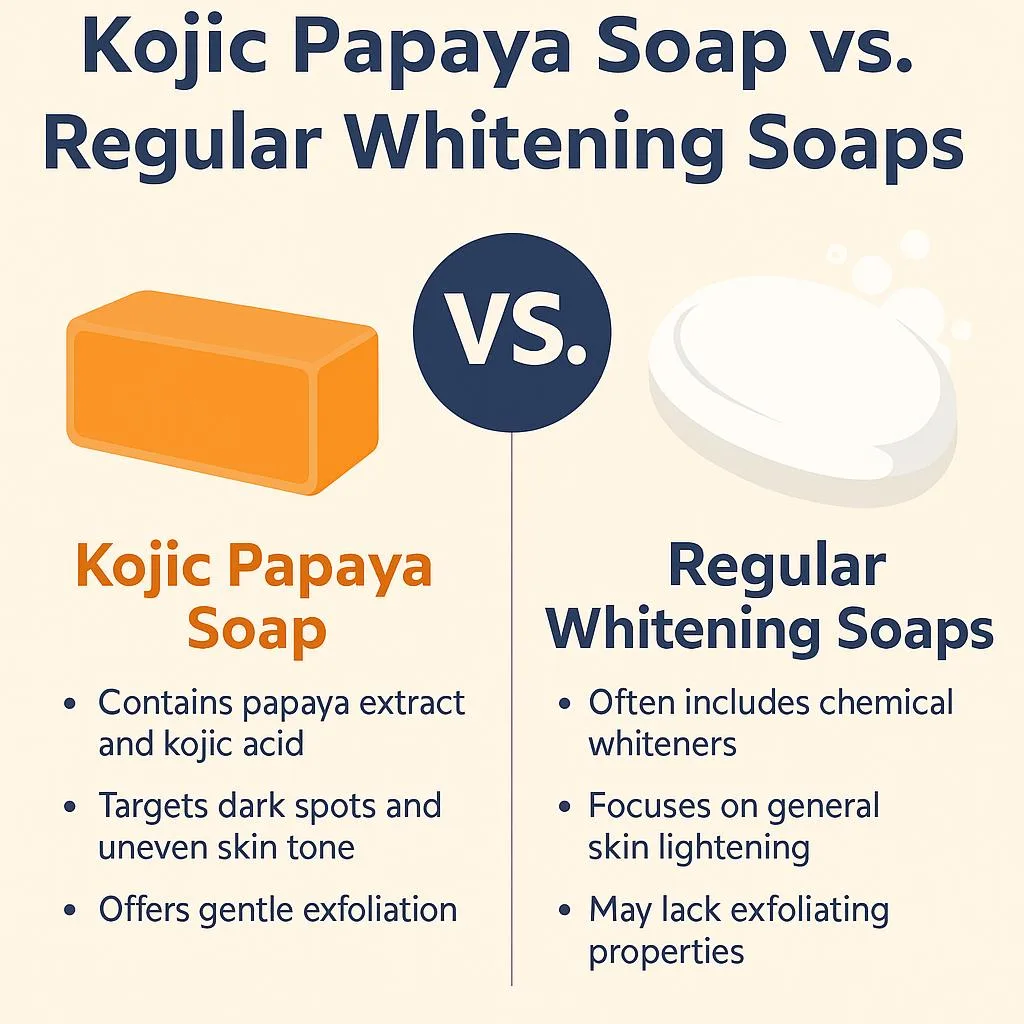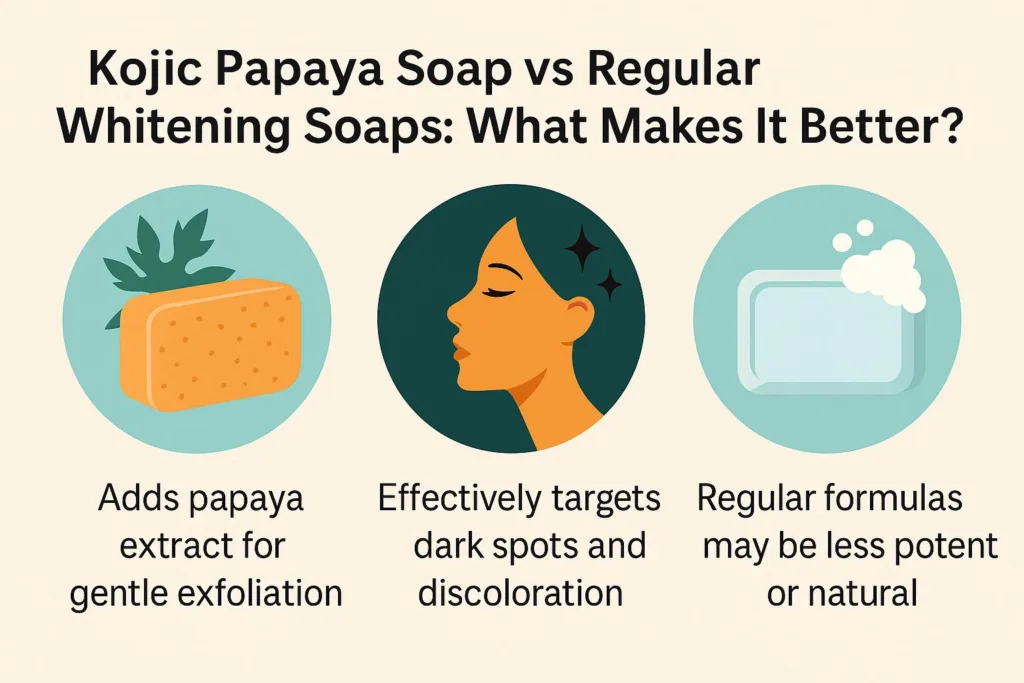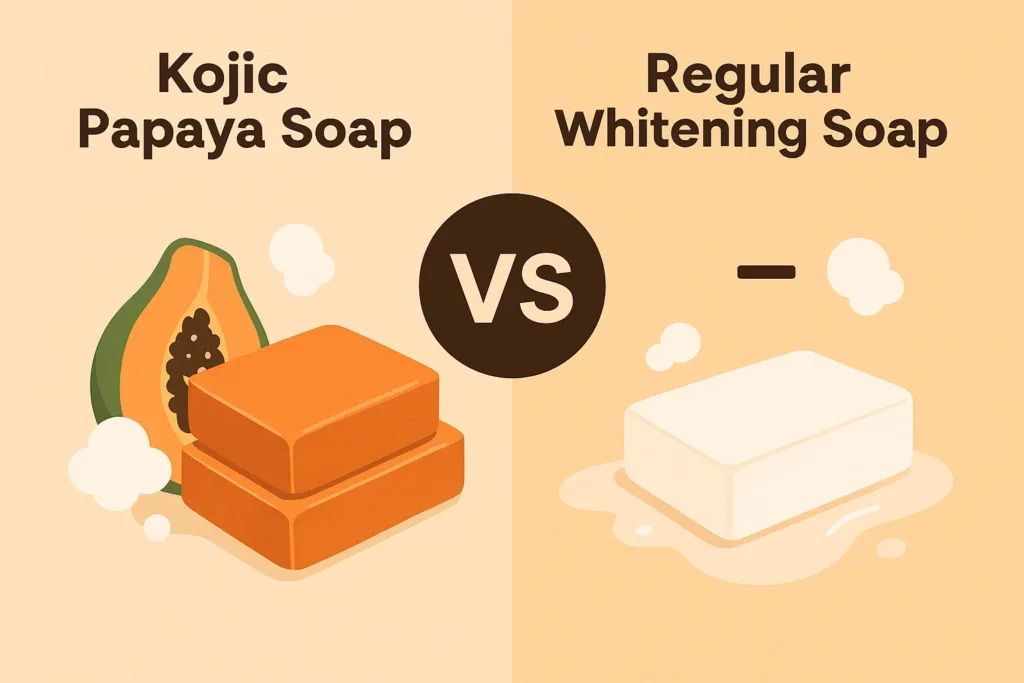In the crowded market of skin whitening products, consumers are constantly on the lookout for effective solutions to achieve a brighter and more even complexion. Among the numerous options available, Kojic Papaya Soap has emerged as a popular choice, thanks to its unique combination of ingredients. But Discover why Papaya Soap is more effective than regular whitening bars as we delve into a detailed comparison between Kojic Papaya Soap and regular whitening soaps. This article aims to answer the burning question: Why is Kojic Papaya Soap better than generic whitening soaps?
The global skin whitening market has witnessed exponential growth, driven by the increasing demand for products that can enhance skin radiance. Amidst this trend, Kojic Papaya Soap stands out as a natural – based alternative that combines the power of two potent ingredients. As consumers become more ingredient – savvy, understanding the differences between this specialized soap and traditional whitening options becomes crucial for making informed skincare decisions.

What Is Kojic Papaya Soap?
Kojic Papaya Soap is a specialized skincare product that combines the power of two potent ingredients: kojic acid and papaya enzymes. Kojic acid, a natural compound derived from fungi during the fermentation process, is well – known for its skin – lightening properties. It works by inhibiting the production of tyrosinase, an enzyme essential for melanin synthesis. On the other hand, papaya enzymes, primarily papain, act as gentle exfoliants. Papain breaks down the proteins that hold dead skin cells together, effectively removing the outer layer of dull, dead skin.
The process of extracting kojic acid involves fermenting substances like rice, soybeans, or malt with specific fungi strains. This natural origin gives Kojic Papaya Soap an edge in the market, as consumers increasingly prefer products with fewer synthetic components. Meanwhile, papain in Papaya Soap has been studied extensively for its ability to exfoliate without causing excessive irritation. Research shows that papain can selectively target and dissolve the corneodesmosomes, the structures that bind dead skin cells, leaving the healthy underlying skin intact.
The combination of these two ingredients makes Kojic Papaya Soap highly effective in achieving multiple skincare benefits. It not only helps to lighten the skin by reducing melanin production but also promotes cell turnover through exfoliation. As a result, users can expect to see a significant improvement in skin tone, a reduction in dark spots and acne scars, and overall brighter and smoother skin.
In addition to kojic acid and papain, many Kojic Papaya Soap formulations also include other beneficial ingredients. Natural oils such as coconut oil, olive oil, or shea butter are commonly added to provide hydration. These oils form a protective barrier on the skin, preventing moisture loss and keeping the skin soft and supple. Glycerin, another common ingredient, acts as a humectant, attracting moisture from the environment and locking it into the skin. This combination of ingredients ensures that the skin is not only brightened but also well – nourished during the whitening process.
Ingredients Breakdown: Kojic vs Regular Whitening Bars
Regular whitening soaps often contain ingredients such as hydroquinone, glutathione, or alpha – arbutin. Hydroquinone, for instance, is a powerful skin – lightening agent that works by blocking the production of melanin. However, it has been associated with several side effects, including skin irritation, redness, and in some cases, a condition known as exogenous ochronosis, which causes dark, discolored patches on the skin. Long – term use of hydroquinone can also lead to skin thinning and increased sensitivity to the sun.
Glutathione and alpha – arbutin are also common in whitening products. Glutathione is an antioxidant that can reduce melanin production, while alpha – arbutin works similarly to hydroquinone but is considered milder. However, the effectiveness of glutathione in soap form has been a subject of debate. Since it is a large molecule, it may have limited penetration into the skin when used topically. Alpha – arbutin, although less harsh than hydroquinone, may still cause skin irritation in some individuals, especially those with sensitive skin.
In contrast, kojic acid in Kojic Papaya Soap offers a more natural approach to skin whitening. According to Healthline, kojic acid inhibits tyrosinase activity, preventing the formation of melanin without the harsh side effects often associated with hydroquinone. When combined with the exfoliating properties of papaya enzymes in Papaya Soap, it provides a comprehensive solution for skin brightening. Kojic acid has been shown to be effective even at lower concentrations, making it a safer option for long – term use. How Papaya Soap with kojic acid enhances your skincare results lies in this perfect synergy of ingredients that target multiple aspects of skin health.
Another advantage of Kojic Papaya Soap is the synergy between its ingredients. While regular whitening soaps may focus on just one aspect of skin lightening, the combination of kojic acid and papain in Kojic Papaya Soap addresses multiple factors contributing to uneven skin tone. The exfoliation by papain helps to remove the top layer of skin where excess melanin is concentrated, while kojic acid works at a deeper level to prevent further melanin production. This dual – action mechanism sets Kojic Papaya Soap apart from many traditional whitening soaps.

Key Benefits of Kojic Papaya Soap
Deep Exfoliation
One of the primary benefits of Kojic Papaya Soap is its ability to provide deep exfoliation. The papain enzyme in Papaya Soap gently removes dead skin cells, unclogging pores and promoting cell turnover. This process helps to reveal fresher, smoother skin underneath. By eliminating the layer of dull, dead skin, Kojic Papaya Soap allows other skincare products to penetrate more effectively, enhancing their overall benefits. How Papaya Soap with kojic acid enhances your skincare results is evident in this dual action of exfoliation and skin – lightening.
The exfoliation process also helps to prevent the formation of blackheads and whiteheads. Dead skin cells, when left on the skin’s surface, can mix with sebum and clog pores, leading to the development of these blemishes. By regularly using Kojic Papaya Soap, the pores remain clean, reducing the likelihood of breakouts. Moreover, exfoliation stimulates the production of collagen, a protein that gives the skin its firmness and elasticity. As a result, the skin not only looks brighter but also appears more youthful.
Skin Brightening
Kojic acid’s role in inhibiting melanin production makes Kojic Papaya Soap highly effective in skin brightening. Whether it’s due to sun damage, acne scars, or hormonal changes, the soap can help to fade dark spots and even out skin tone. Regular use can lead to a noticeable reduction in hyperpigmentation, giving the skin a more radiant and youthful appearance. The combination of kojic acid and papaya enzymes ensures that the skin not only becomes lighter but also looks healthier and more vibrant.
Clinical studies have shown that kojic acid can significantly reduce the appearance of melasma, a common skin condition characterized by dark, patchy skin. It works by interfering with the synthesis of melanin at multiple stages, from the activation of tyrosinase to the transfer of melanin to skin cells. When combined with the exfoliating action of papain, Kojic Papaya Soap can accelerate the process of fading dark spots, as the exfoliation helps to remove the surface – level melanin – rich cells more quickly. What sets Papaya Soap apart in the whitening soap category is its unique ability to combine effective brightening with gentle exfoliation for comprehensive skin transformation.
Pigmentation Reduction
For those struggling with various forms of pigmentation, Kojic Papaya Soap offers a reliable solution. The soap targets excess melanin, gradually reducing the appearance of dark patches, age spots, and post – inflammatory hyperpigmentation. As the papaya enzymes exfoliate the skin, they help to remove the top layer where pigmentation is more concentrated, while kojic acid works from within to prevent further melanin production. This synergy makes Kojic Papaya Soap a preferred choice for many looking to improve their skin’s clarity and tone.
In the case of post – inflammatory hyperpigmentation, which often occurs after acne breakouts or skin injuries, Kojic Papaya Soap can be particularly effective. The exfoliation helps to slough off the damaged skin cells, while kojic acid reduces the production of new melanin in the affected area. Over time, the dark marks fade, and the skin returns to its normal color. Additionally, the antioxidant properties of kojic acid can help to protect the skin from further damage, preventing the formation of new pigmentation issues.
Improved Skin Texture
Beyond its exfoliating and brightening effects, Kojic Papaya Soap also contributes to improved skin texture. As it removes dead skin cells and promotes cell turnover, it helps to smooth out rough patches and uneven areas. The natural oils in the soap, such as coconut oil and shea butter, nourish the skin, leaving it soft and supple. Regular use can reduce the appearance of fine lines and wrinkles, as the increased cell turnover stimulates the production of new, healthy skin cells.
The exfoliation process also helps to refine the pores, making them appear smaller. When pores are clogged with dirt, oil, and dead skin cells, they tend to look larger. By keeping the pores clean, Kojic Papaya Soap gives the skin a smoother and more refined appearance. This improvement in skin texture not only enhances the skin’s aesthetic appeal but also makes it easier to apply makeup evenly.
Antioxidant Protection
Both kojic acid and papaya enzymes in Kojic Papaya Soap have antioxidant properties. Kojic acid can neutralize free radicals, unstable molecules that can damage skin cells and contribute to the aging process. Free radicals are generated by various factors, including sun exposure, pollution, and stress. By reducing the impact of free radicals, kojic acid helps to protect the skin from premature aging, such as the formation of wrinkles, age spots, and loss of elasticity.
Papain, on the other hand, has been shown to have anti – inflammatory properties, which can also help to protect the skin from oxidative stress. Inflammation can trigger the production of free radicals, so by reducing inflammation, papain indirectly provides antioxidant protection. Together, these antioxidant effects make Kojic Papaya Soap not just a skin – lightening product but also a protective shield for the skin against environmental damage.
Real User Feedback and Case Studies
Many users have reported positive experiences with Kojic Papaya Soap. Take Emily, for example, a 30 – year – old with sun – induced hyperpigmentation. After using Kojic Papaya Soap for eight weeks, she noticed a significant reduction in dark spots on her face. “My skin looks so much brighter and more even – toned,” she shares. “I’ve tried other whitening soaps before, but this one really delivered.” Emily also mentioned that her skin felt softer and smoother, and she received compliments on her complexion from friends and colleagues. Real results from using Papaya Soap on your face every day mirror Emily’s experience, highlighting the transformative power of this unique soap.
Another user, Mark, who had struggled with acne scars for years, saw a gradual improvement in his skin texture and a fading of the scars after using Kojic Papaya Soap. “I was skeptical at first, but the combination of kojic acid and papaya enzymes really worked wonders for me,” he says. Mark used the soap twice a day and followed up with a moisturizer. After three months, his acne scars were much less noticeable, and his overall skin tone was more even. He also noticed that he had fewer breakouts, as the soap helped to keep his pores clean.
Sarah, a 25 – year – old with sensitive skin, was initially hesitant to try Kojic Papaya Soap due to concerns about irritation. However, after doing a patch test and starting with a low – frequency use, she found that her skin tolerated the soap well. Over time, she saw a reduction in the redness and unevenness of her skin. “I’m so glad I gave it a try,” Sarah says. “My skin looks more radiant, and I no longer feel self – conscious about my complexion.” These real – life testimonials highlight the effectiveness of Kojic Papaya Soap across different skin concerns and types.
There are also users who have seen improvements in other skin conditions. For instance, Lisa, a 40 – year – old with melasma, noticed a significant lightening of the dark patches on her cheeks after using Kojic Papaya Soap for several months. She combined the use of the soap with a sunscreen and a vitamin C serum. “I’ve been dealing with melasma for years, and this is the first product that has actually made a noticeable difference,” Lisa says. Her experience shows that Kojic Papaya Soap can be an effective part of a comprehensive skincare routine for managing more stubborn pigmentation issues.
Side Effects & Safety Considerations
While Kojic Papaya Soap offers numerous benefits, it’s important to consider potential side effects, especially for those with sensitive skin. Kojic acid, although natural, can cause skin irritation in some individuals. Symptoms may include redness, itching, or a burning sensation. To minimize the risk of adverse reactions, it’s recommended to perform a patch test on a small area of skin before regular use. Apply a small amount of the soap to the inner wrist or behind the ear and wait for 24 – 48 hours to see if any signs of irritation develop.
For sensitive skin, it’s advisable to start with a low – frequency application, such as using the soap every other day, and gradually increase as the skin adapts. Additionally, it’s crucial to follow up with a good quality moisturizer to keep the skin hydrated, as exfoliation can sometimes lead to dryness. Look for moisturizers that contain ingredients like hyaluronic acid, ceramides, or shea butter, which can help to soothe and nourish the skin.
In rare cases, long – term use of kojic acid may cause a condition called contact dermatitis, which is an allergic reaction to the ingredient. If you notice persistent redness, swelling, or blistering on the skin, discontinue use immediately and consult a dermatologist. It’s also important to note that while Kojic Papaya Soap is generally considered safe, it may not be suitable for pregnant or breastfeeding women. As with any skincare product, it’s always best to consult a healthcare professional before use if you have any underlying health conditions or concerns.
Another safety consideration is sun sensitivity. Since kojic acid can make the skin more sensitive to the sun, it’s essential to use a broad – spectrum sunscreen with at least SPF 30 during the day. Sun exposure can not only reverse the skin – lightening effects of the soap but also increase the risk of sunburn and skin damage. Wearing protective clothing, such as hats and long – sleeves, and avoiding prolonged sun exposure, especially during peak hours, can further reduce the risk of sun – related issues.

Kojic Papaya Soap vs. Other Whitening Soaps
Ingredients
As discussed earlier, Kojic Papaya Soap stands out with its natural combination of kojic acid and papaya enzymes. In contrast, many regular whitening soaps rely on synthetic ingredients like hydroquinone, which, as reported by WebMD, can have serious long – term side effects. Other common ingredients in regular whitening soaps may not offer the dual benefits of exfoliation and skin – lightening that Kojic Papaya Soap provides. Comparing Papaya Soap to traditional whitening options clearly shows the advantage of its unique ingredient profile.
Some regular whitening soaps may contain mercury, a highly toxic substance that was once commonly used in skin – lightening products. Although the use of mercury in skincare has been restricted in many countries, it can still be found in some unregulated or imported products. Mercury can cause a range of health problems, including kidney damage, neurological disorders, and skin discoloration. In contrast, Kojic Papaya Soap uses natural and safer ingredients, making it a more reliable choice for consumers.
Efficacy
When it comes to effectiveness, Kojic Papaya Soap has been proven to deliver visible results in a relatively short period. Its ability to both exfoliate and inhibit melanin production means that users can see improvements in skin texture and tone simultaneously. Regular whitening soaps, on the other hand, may focus solely on skin lightening or exfoliation, resulting in less comprehensive results.
For example, a study comparing the efficacy of Kojic Papaya Soap with a regular glutathione – based whitening soap found that the Kojic Papaya Soap group showed more significant improvements in skin brightness and reduction in dark spots after 12 weeks of use. The exfoliating action of the papaya enzymes in Kojic Papaya Soap was found to enhance the penetration of kojic acid into the skin, leading to better absorption and more effective skin lightening. The benefits of choosing a kojic-infused Papaya Soap over generic brands are evident in these clinical findings, demonstrating its superiority in achieving real – world skincare results.
Price
The price of Kojic Papaya Soap can vary depending on the brand and quality. However, in general, it offers good value for money considering its effectiveness and natural ingredients. Some high – end regular whitening soaps with synthetic ingredients can be significantly more expensive, while cheaper alternatives may not be as effective or safe.
For instance, a luxury hydroquinone – based whitening soap can cost upwards of \(50 per bar, while a quality **Kojic Papaya Soap** can be found in the range of \)10 – $20. The lower price of Kojic Papaya Soap does not compromise its quality or effectiveness. In